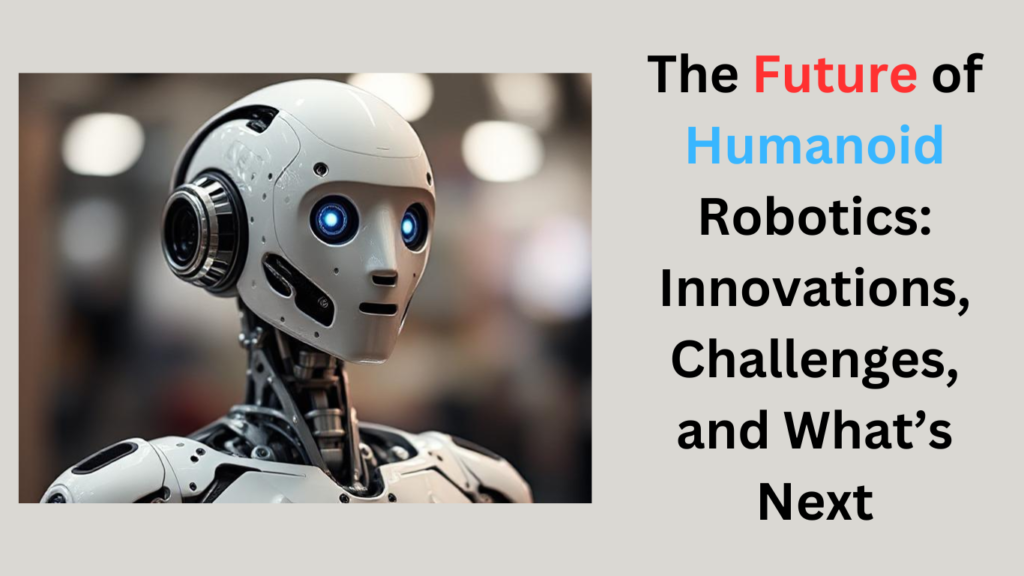The Future of Humanoid Robotics: Innovations, Challenges, and What’s Next

Introduction
Humanoid robots are advancing at an unprecedented rate, with companies worldwide pushing the boundaries of artificial intelligence, dexterity, and real-world applications. From Sanctuary AI’s tactile sensor enhancements to Boston Dynamics’ electric Atlas, the robotics industry is heading towards a new era of automation and intelligent machines. This blog explores the latest developments, key players, and the future of humanoid robotics.
1. The Rise of Humanoid Robotics
Robots are no longer just stationary machines performing repetitive tasks in factories. With AI, advanced sensors, and cutting-edge actuators, humanoid robots are becoming more capable of interacting with the real world. Companies are now focusing on improving dexterity, mobility, and real-time decision-making to make robots more autonomous and useful in various industrie
2. Sanctuary AI – Enhancing Dexterity with Tactile Sensors
Sanctuary AI has been pioneering general-purpose humanoid robotics and recently introduced new tactile sensors in their Phoenix robots. These sensors allow the robots to feel pressure, detect object slippage, and handle delicate objects with precision. The significance of these sensors is immense:
- Improved Manipulation – Robots can perform tasks requiring dexterity, such as assembling small components.
- Enhanced Remote Control – Operators can sense objects virtually, making remote work more intuitive.
- Higher Efficiency – Reduces the number of repeated attempts required to grasp and manipulate objects.
With these enhancements, Sanctuary AI is positioning itself at the forefront of humanoid dexterity, focusing more on manipulation rather than mobility.
3. Boston Dynamics – The Next-Gen Electric Atlas
Boston Dynamics, known for its high-performing robots, recently unveiled the next-generation electric Atlas. Unlike its hydraulic predecessor, this version is entirely electric, offering:
- Improved Agility – The robot dynamically adjusts joint stiffness to balance heavy loads.
- AI-Powered Sequencing – It autonomously decides which object to pick and where to place it.
- Real-World Applications – Designed for automotive assembly lines and other industries requiring precise mechanical work.
This innovation brings humanoid robots a step closer to being integrated into real-world industries at scale.
4. Ameca – The Most Lifelike AI Robot
Engineered Arts’ Ameca is arguably the most lifelike humanoid robot to date. With ultra-realistic facial expressions, interactive speech, and advanced AI, it has gained widespread attention. At the Mobile World Congress, Ameca responded with wit when asked about robots taking over jobs, making it feel eerily human.
- Advanced AI Communication – Can engage in natural conversations and mimic human-like gestures.
- High-Precision Facial Recognition – Recognizes and responds to people based on expressions.
- Entertainment and Marketing Applications – Used in exhibitions, marketing events, and research labs.
Though not yet fully mobile, Ameca is expected to gain movement capabilities in the future.
5. MS Robotics – Preparing Robots for Space Exploration
Pushing the boundaries of exploration, MS Robotics is developing humanoid robots for planetary colonization. Their key projects include:
- SpaceO Prime – A bipedal humanoid designed for interplanetary habitat construction.
- Robo Prime – Specialized for navigating rugged Martian terrain and conducting scientific research.
- Real-Time Data Transmission – Robots collect and send planetary data back to Earth.
With collaborations with India’s Defense Research and Development Organization (DRDO), these robots could play a pivotal role in future space missions.
6. Huawei’s 5G-Powered Humanoid and the Future of Robotics
Huawei has unveiled the world’s first 5G-powered humanoid robot, developed in collaboration with China Mobile and LUU Robotics. This robot is unique because it relies on 5G networks for real-time processing rather than onboard hardware. Benefits include:
- Ultra-Low Latency – Faster decision-making and better response times.
- Cloud Computing – Reduces the need for bulky processors, making robots lighter and cheaper.
- Remote Operations – Allows operators to control robots from thousands of miles away.
5G-powered robotics could revolutionize industries like healthcare, manufacturing, and emergency response by providing seamless automation.
FAQs on Humanoid Robotics
Q1: What is the most advanced humanoid robot today?
A1: Currently, Boston Dynamics’ Atlas, Sanctuary AI’s Phoenix, and Engineered Arts’ Ameca are considered among the most advanced.
Q2: Can humanoid robots think like humans?
A2: Not yet. They use AI and machine learning for decision-making, but they do not possess self-awareness or true cognitive abilities.
Q3: What industries will benefit the most from humanoid robots?
A3: Industries like manufacturing, logistics, space exploration, healthcare, and entertainment are expected to see significant benefits.
Q4: How much does a humanoid robot cost?
A4: Prices range from $20,000 to several million dollars, depending on the level of sophistication and applications.
Q5: Will robots replace human jobs?
A5: While some jobs may be automated, new roles in AI maintenance, robotics development, and automation management will emerge.